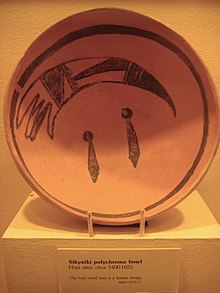
Back أساطير هوبية Arabic Mitologia hopi Catalan Μυθολογία Χόπι Greek Mitología hopi Spanish Hopimythologie Dutch

The Hopi maintain a complex religious and mythological tradition stretching back over centuries. However, it is difficult to definitively state what all Hopis as a group believe. Like the oral traditions of many other societies, Hopi mythology is not always told consistently and each Hopi mesa, or even each village, may have its own version of a particular story, but "in essence the variants of the Hopi myth bear marked similarity to one another."[1] It is also not clear that the stories told to non-Hopis, such as anthropologists and ethnographers, represent genuine Hopi beliefs or are merely stories told to the curious while keeping safe the more sacred Hopi teachings. As folklorist Harold Courlander states, "there is a Hopi reticence about discussing matters that could be considered ritual secrets or religion-oriented traditions."[2]
In addition, the Hopis have always been willing to assimilate foreign ideas into their cosmology if they are proven effective for such practical necessities as bringing rain.[3] The Hopi had at least some contact with Europeans as early as the 16th century, and some believe that European Christian traditions may have entered Hopi cosmology at some point. Indeed, Spanish missions were built in several Hopi villages starting in 1629 and were in operation until the Pueblo Revolt of 1680. However, after the revolt, it was the Hopi alone of all the Pueblo peoples who kept the Spanish out of their villages permanently, and regular contact with whites did not begin again until nearly two centuries later. The Hopi mesas have therefore been seen as "relatively unacculturated" at least through the early 20th century, and it may be posited that the European influence on the core themes of Hopi mythology was slight.[citation needed]
- ^ Christopher Vecsey. The Emergence of the Hopi People, in American Indian Quarterly, vol. 7, no. 3, American Indian Religions, 70 (Summer 1983).
- ^ Harold Courlander. The Fourth World of the Hopis: The Epic Story of the Hopi Indians as Preserved in their Legends and Traditions, 201 University of New Mexico Press, 1987
- ^ Susan E. James. "Some Aspects of the Aztec Religion in the Hopi Kachina Cult", Journal of the Southwest (2000)
© MMXXIII Rich X Search. We shall prevail. All rights reserved. Rich X Search